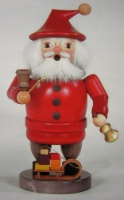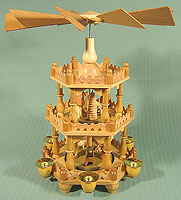Christkindl Markets or Weihnachtsmarkt History
Posted by Patti Silla on 1st Jul 2014
Germany is known for its beautiful Christmas markets called, Christkindlmarkets, which are located throughout Germany and Austria. These are stunning open-air markets with gorgeous lights and decorated little huts selling homemade crafts like little figurines and carved toys made of shaved and polished wood, dainty ornaments like the sebnitz and Moravian stars, picture windows with tiny figurines and songs coming from exquisite music boxes and cuckoo clocks. Many of these items are imported directly from Germany to Christmas markets in the States. There is an intriguing history regarding the development of these festive markets.
Originally, in Germany, the main winter holiday was Saint Nicholas' feast day on December 6th. This was a time for friends and family to gather and give presents to children on behalf of thisbeloved saint. With the rise of Martin Luther and the Reformation, when Germany became a Protestant nation, Saint Nicholas' feast diminished in its festivities. It was hard for the Protestants to simple eliminate a much-awaited festive day, especially as the days were cold and dreary, people needed some activity to brighten the winter months. In solution, the Protestants replaced what they considered a Catholic holiday, Saint Nicholas’ feast day, with celebrations on a new day, December 25th, for the birth of the Christ Child.
 Instead of Saint Nick gifting the children, a new legend was begun where the "Christ child" would give gifts on Christmas Eve. Rumor has it that he would arrive with the gifts riding a mule and traveling through closed doors. Although we still remember Saint Nicholas in the form of "Father Christmas" or Santa Claus, impersonations of him can be found in shopping centers around the world. You can even find Santa figurines in the German Christmas markets as you can see from the smoker to the right, for the most part, however, his feast day has faded with the rise of this new "Christmas" holiday. Ironically, the German words for "Christ Child" or "Christ Kindl" have been used in pronunciation of "Kris Kringle" the American name for Santa Claus as these two holidays have melded together.
Instead of Saint Nick gifting the children, a new legend was begun where the "Christ child" would give gifts on Christmas Eve. Rumor has it that he would arrive with the gifts riding a mule and traveling through closed doors. Although we still remember Saint Nicholas in the form of "Father Christmas" or Santa Claus, impersonations of him can be found in shopping centers around the world. You can even find Santa figurines in the German Christmas markets as you can see from the smoker to the right, for the most part, however, his feast day has faded with the rise of this new "Christmas" holiday. Ironically, the German words for "Christ Child" or "Christ Kindl" have been used in pronunciation of "Kris Kringle" the American name for Santa Claus as these two holidays have melded together.
Before the actual Christmas Day celebration was a period of Advent, or of anticipation of the "arrival of the Christ." Today this period is recognized as the four Sundays before Christmas, but initially it lasted for six weeks beginning in the last week of November. Unlike the Saint Nicholas feast, this Catholic tradition was continued by the Protestants in the area. They acknowledge the full length of advent in part, as the German Christmas markets and shopping centers around the world do, by extending the holiday shopping season from the last week in November to Christmas Eve.
During this period, farmers, tradesmen and artisans would meet around the churches. These gatherings became open-air markets. The first documented open winter market on or near December 25th was held in 1310 in Munich, Germany. Original celebrations included gathering around the Church with song, food and small gifts. These were such a hit with the local populations that people would come and "set up shop" in the streets around the churches where they would sell homemade crafts. Some of the crafts are timeless and can still be found in the markets today, like nutcrackers, German smokers filled with wafting incense, cuckoo clocks, music boxes, shaved wood and tin tree ornaments as well as favorite foods like grilled bratwurst, gingerbread cookies, candied nuts, baked apples and Glühwein, or spiced warm wine.
As the majority of churches at that time were located in the center of the towns as the gatherings grew, they began to overtake the town squares. What was once individuals laying goods out on sheets in the streets quickly became groups of small huts. Some of these huts sold pyramids, which were made of light woods; traditionally the nativity scene would be in the middle with angels, shepherds, farm animals, wise men, etc. on outer layers. These would light the huts and the heat from the candles would cause the outer layer of angels and others to circle around the Christ Child. Nuremberg was the first city to give a name to this celebration calling it, "Christkindlsmarkt." Like the center of the German pyramids, the "Christ Child" was the center of these festivities. Christkindlsmarkt is a compounded noun, typical in German, that when translated literally means "Christ child market". Today, markets in Munich, Dresden, Stuttgart, Salzburg, etc. all begin with a welcome of the Christkindl with a local youth dressed as an angel and have choirs singing Christmas carols.
 Other names for the Christkindlmarkts or German Christmas Markets are: Cristkindlmarkt, Striezelmarkt, Weihnachtsmarkt. A typical Christkindlmarkt is located alongstreets and features a large decorated tree, provided usually by the City as well as numerous nativity scenes. They are most popularly visited in the evening hours when the twinkle lights are more easily appreciated. More than anything however, these Christmas markets are known for the quality of craftsmanship found in its handmade German nutcrackers, angelic figurines, shaved wood tree ornaments, cuckoo clocks, and German smokers characterizing occupations of every kind. These crafts differ greatly from the mass-produced wares found in most American stores and remind us of a slower, less complicated era.
Other names for the Christkindlmarkts or German Christmas Markets are: Cristkindlmarkt, Striezelmarkt, Weihnachtsmarkt. A typical Christkindlmarkt is located alongstreets and features a large decorated tree, provided usually by the City as well as numerous nativity scenes. They are most popularly visited in the evening hours when the twinkle lights are more easily appreciated. More than anything however, these Christmas markets are known for the quality of craftsmanship found in its handmade German nutcrackers, angelic figurines, shaved wood tree ornaments, cuckoo clocks, and German smokers characterizing occupations of every kind. These crafts differ greatly from the mass-produced wares found in most American stores and remind us of a slower, less complicated era.
To visit Germany and the Christkindlesmarkts: click here
For a recipe for Christmas Glühwein: click here
